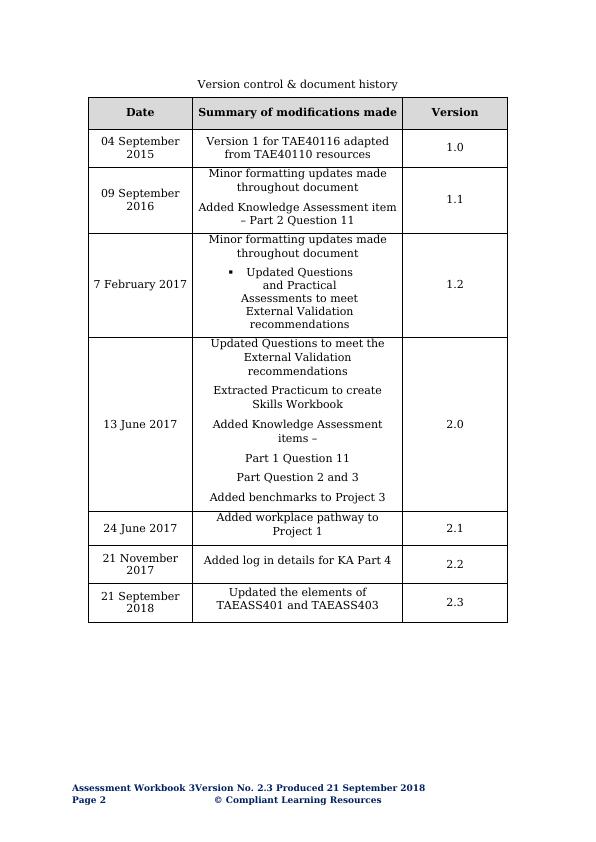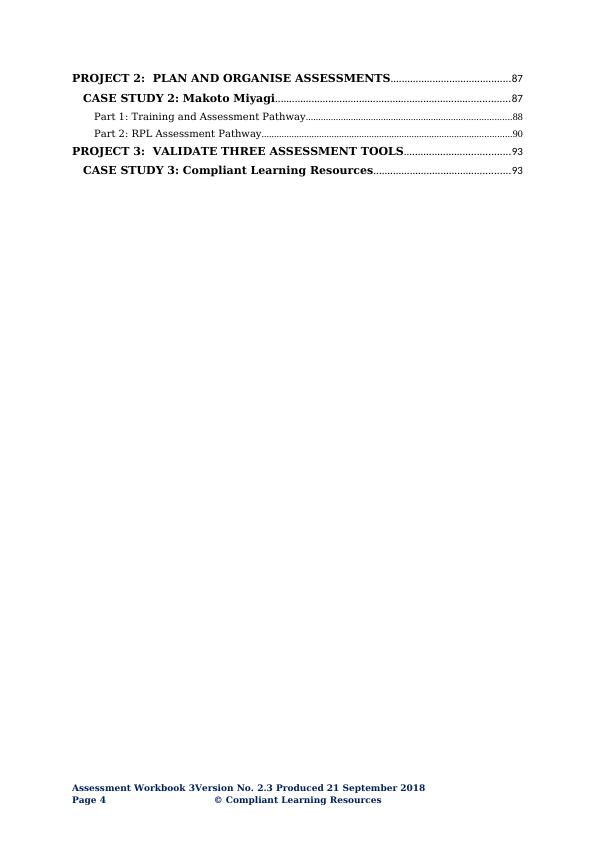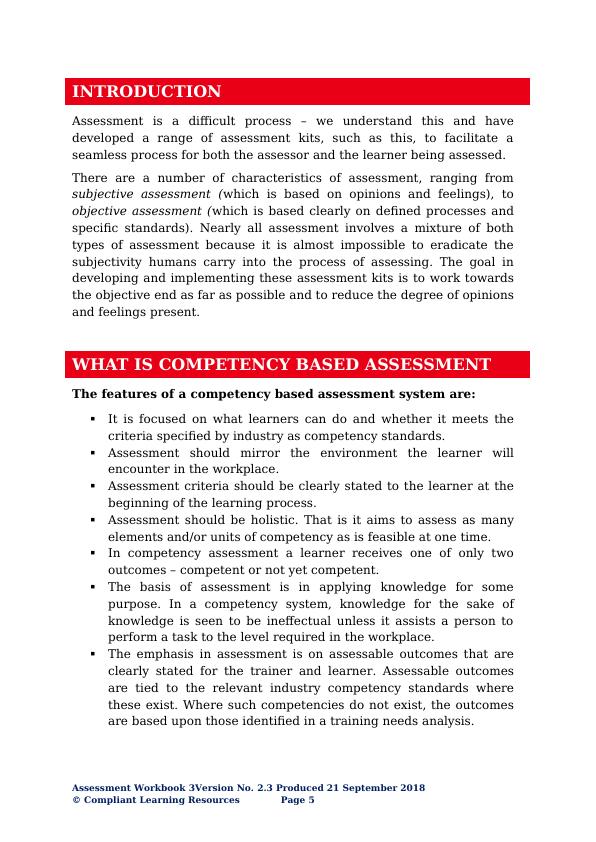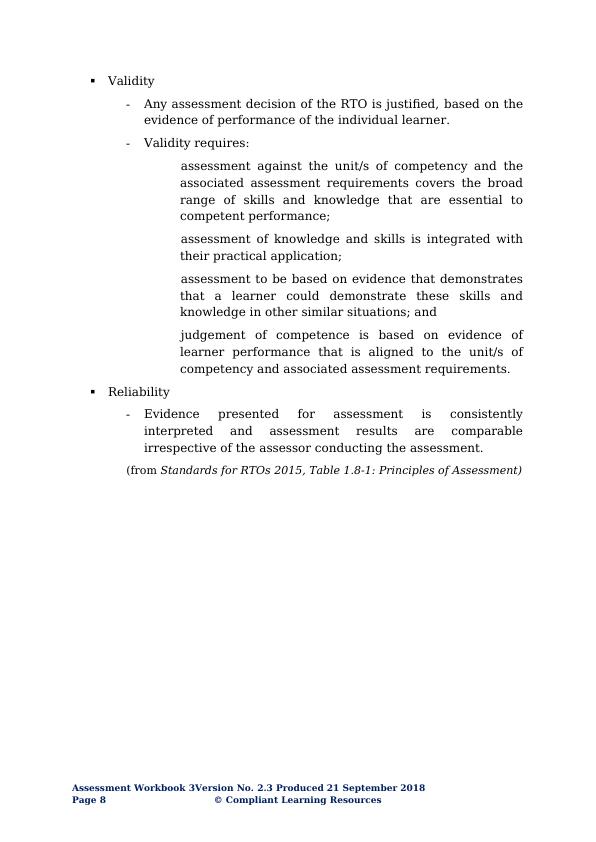Assessment Workbook 3 - TAE40116 Certificate IV
Added on 2023-04-21
118 Pages21147 Words157 Views
TAE40116 Certificate IV
in Training and
Assessment
Assessment Cluster
Version 2.3 Produced 21 September 2018
Copyright © 2018 Compliant Learning Resources. All rights reserved. No part of this publication
may be reproduced or distributed in any form or by any means, or stored in a database or retrieval
system other than pursuant to the terms of the Copyright Act 1968 (Commonwealth), without the
prior written permission of
Compliant Learning Resources
Assessment Workbook 3
in Training and
Assessment
Assessment Cluster
Version 2.3 Produced 21 September 2018
Copyright © 2018 Compliant Learning Resources. All rights reserved. No part of this publication
may be reproduced or distributed in any form or by any means, or stored in a database or retrieval
system other than pursuant to the terms of the Copyright Act 1968 (Commonwealth), without the
prior written permission of
Compliant Learning Resources
Assessment Workbook 3

Version control & document history
Date Summary of modifications made Version
04 September
2015
Version 1 for TAE40116 adapted
from TAE40110 resources 1.0
09 September
2016
Minor formatting updates made
throughout document
Added Knowledge Assessment item
– Part 2 Question 11
1.1
7 February 2017
Minor formatting updates made
throughout document
Updated Questions
and Practical
Assessments to meet
External Validation
recommendations
1.2
13 June 2017
Updated Questions to meet the
External Validation
recommendations
Extracted Practicum to create
Skills Workbook
Added Knowledge Assessment
items –
Part 1 Question 11
Part Question 2 and 3
Added benchmarks to Project 3
2.0
24 June 2017 Added workplace pathway to
Project 1 2.1
21 November
2017 Added log in details for KA Part 4 2.2
21 September
2018
Updated the elements of
TAEASS401 and TAEASS403 2.3
Assessment Workbook 3Version No. 2.3 Produced 21 September 2018
Page 2 © Compliant Learning Resources
Date Summary of modifications made Version
04 September
2015
Version 1 for TAE40116 adapted
from TAE40110 resources 1.0
09 September
2016
Minor formatting updates made
throughout document
Added Knowledge Assessment item
– Part 2 Question 11
1.1
7 February 2017
Minor formatting updates made
throughout document
Updated Questions
and Practical
Assessments to meet
External Validation
recommendations
1.2
13 June 2017
Updated Questions to meet the
External Validation
recommendations
Extracted Practicum to create
Skills Workbook
Added Knowledge Assessment
items –
Part 1 Question 11
Part Question 2 and 3
Added benchmarks to Project 3
2.0
24 June 2017 Added workplace pathway to
Project 1 2.1
21 November
2017 Added log in details for KA Part 4 2.2
21 September
2018
Updated the elements of
TAEASS401 and TAEASS403 2.3
Assessment Workbook 3Version No. 2.3 Produced 21 September 2018
Page 2 © Compliant Learning Resources

TABLE OF CONTENTS
This is an interactive table of contents. If you are viewing this document
in Acrobat, clicking on a heading will transfer you to that page. If you
have this document open in Word, you will need to hold down the Control
key while clicking for this to work.
TABLE OF CONTENTS.............................................................................................................3
INTRODUCTION..........................................................................................................................5
WHAT IS COMPETENCY BASED ASSESSMENT........................................................5
THE BASIC PRINCIPLES OF ASSESSING NATIONALLY RECOGNISED
TRAINING.......................................................................................................................................6
THE DIMENSIONS OF COMPETENCY............................................................................8
REASONABLE ADJUSTMENT..............................................................................................9
THE UNITS OF COMPETENCY..........................................................................................11
CONTEXT FOR ASSESSMENT...........................................................................................13
ASSESSMENT REQUIREMENTS......................................................................................13
ASSESSMENT METHODS....................................................................................................15
RESOURCES REQUIRED FOR ASSESSMENT...........................................................17
INSTRUCTIONS TO STUDENT..........................................................................................18
ASSESSMENT WORKBOOK COVER SHEET..............................................................19
KNOWLEDGE ASSESSMENT..............................................................................................20
Part 1 – Competency-based assessments........................................................................................20
Part 2 – Assessment Tools...............................................................................................................28
Part 3 – Validation...........................................................................................................................38
Part 4 – Standards, Policies & Procedures.......................................................................................44
Part 5 – Workplace Health and Safety.............................................................................................46
PRACTICAL ASSESSMENTS...............................................................................................53
Instructions to Student.....................................................................................................53
Project 1: Develop Three Assessment Tools.......................................................................................54
Workplace Pathway.........................................................................................................................56
Step 1: Plan development of assessment tool............................................................................57
Step 2: Develop assessment tool.....................................................................................................63
Step 3: Review and trial assessment tool.....................................................................................65
Simulated Pathway..............................................................................................................71
CASE STUDY 1: Compliant Learning Resources........................................................................................72
Step 1: Plan development of assessment tool............................................................................75
Step 2: Develop assessment tool.....................................................................................................80
Step 3: Review and trial assessment tool.....................................................................................82
Assessment Workbook 3Version No. 2.3 Produced 21 September 2018
© Compliant Learning Resources Page 3
This is an interactive table of contents. If you are viewing this document
in Acrobat, clicking on a heading will transfer you to that page. If you
have this document open in Word, you will need to hold down the Control
key while clicking for this to work.
TABLE OF CONTENTS.............................................................................................................3
INTRODUCTION..........................................................................................................................5
WHAT IS COMPETENCY BASED ASSESSMENT........................................................5
THE BASIC PRINCIPLES OF ASSESSING NATIONALLY RECOGNISED
TRAINING.......................................................................................................................................6
THE DIMENSIONS OF COMPETENCY............................................................................8
REASONABLE ADJUSTMENT..............................................................................................9
THE UNITS OF COMPETENCY..........................................................................................11
CONTEXT FOR ASSESSMENT...........................................................................................13
ASSESSMENT REQUIREMENTS......................................................................................13
ASSESSMENT METHODS....................................................................................................15
RESOURCES REQUIRED FOR ASSESSMENT...........................................................17
INSTRUCTIONS TO STUDENT..........................................................................................18
ASSESSMENT WORKBOOK COVER SHEET..............................................................19
KNOWLEDGE ASSESSMENT..............................................................................................20
Part 1 – Competency-based assessments........................................................................................20
Part 2 – Assessment Tools...............................................................................................................28
Part 3 – Validation...........................................................................................................................38
Part 4 – Standards, Policies & Procedures.......................................................................................44
Part 5 – Workplace Health and Safety.............................................................................................46
PRACTICAL ASSESSMENTS...............................................................................................53
Instructions to Student.....................................................................................................53
Project 1: Develop Three Assessment Tools.......................................................................................54
Workplace Pathway.........................................................................................................................56
Step 1: Plan development of assessment tool............................................................................57
Step 2: Develop assessment tool.....................................................................................................63
Step 3: Review and trial assessment tool.....................................................................................65
Simulated Pathway..............................................................................................................71
CASE STUDY 1: Compliant Learning Resources........................................................................................72
Step 1: Plan development of assessment tool............................................................................75
Step 2: Develop assessment tool.....................................................................................................80
Step 3: Review and trial assessment tool.....................................................................................82
Assessment Workbook 3Version No. 2.3 Produced 21 September 2018
© Compliant Learning Resources Page 3

PROJECT 2: PLAN AND ORGANISE ASSESSMENTS...........................................87
CASE STUDY 2: Makoto Miyagi....................................................................................87
Part 1: Training and Assessment Pathway..................................................................................88
Part 2: RPL Assessment Pathway....................................................................................................90
PROJECT 3: VALIDATE THREE ASSESSMENT TOOLS......................................93
CASE STUDY 3: Compliant Learning Resources.................................................93
Assessment Workbook 3Version No. 2.3 Produced 21 September 2018
Page 4 © Compliant Learning Resources
CASE STUDY 2: Makoto Miyagi....................................................................................87
Part 1: Training and Assessment Pathway..................................................................................88
Part 2: RPL Assessment Pathway....................................................................................................90
PROJECT 3: VALIDATE THREE ASSESSMENT TOOLS......................................93
CASE STUDY 3: Compliant Learning Resources.................................................93
Assessment Workbook 3Version No. 2.3 Produced 21 September 2018
Page 4 © Compliant Learning Resources

INTRODUCTION
Assessment is a difficult process – we understand this and have
developed a range of assessment kits, such as this, to facilitate a
seamless process for both the assessor and the learner being assessed.
There are a number of characteristics of assessment, ranging from
subjective assessment (which is based on opinions and feelings), to
objective assessment (which is based clearly on defined processes and
specific standards). Nearly all assessment involves a mixture of both
types of assessment because it is almost impossible to eradicate the
subjectivity humans carry into the process of assessing. The goal in
developing and implementing these assessment kits is to work towards
the objective end as far as possible and to reduce the degree of opinions
and feelings present.
WHAT IS COMPETENCY BASED ASSESSMENT
The features of a competency based assessment system are:
It is focused on what learners can do and whether it meets the
criteria specified by industry as competency standards.
Assessment should mirror the environment the learner will
encounter in the workplace.
Assessment criteria should be clearly stated to the learner at the
beginning of the learning process.
Assessment should be holistic. That is it aims to assess as many
elements and/or units of competency as is feasible at one time.
In competency assessment a learner receives one of only two
outcomes – competent or not yet competent.
The basis of assessment is in applying knowledge for some
purpose. In a competency system, knowledge for the sake of
knowledge is seen to be ineffectual unless it assists a person to
perform a task to the level required in the workplace.
The emphasis in assessment is on assessable outcomes that are
clearly stated for the trainer and learner. Assessable outcomes
are tied to the relevant industry competency standards where
these exist. Where such competencies do not exist, the outcomes
are based upon those identified in a training needs analysis.
Assessment Workbook 3Version No. 2.3 Produced 21 September 2018
© Compliant Learning Resources Page 5
Assessment is a difficult process – we understand this and have
developed a range of assessment kits, such as this, to facilitate a
seamless process for both the assessor and the learner being assessed.
There are a number of characteristics of assessment, ranging from
subjective assessment (which is based on opinions and feelings), to
objective assessment (which is based clearly on defined processes and
specific standards). Nearly all assessment involves a mixture of both
types of assessment because it is almost impossible to eradicate the
subjectivity humans carry into the process of assessing. The goal in
developing and implementing these assessment kits is to work towards
the objective end as far as possible and to reduce the degree of opinions
and feelings present.
WHAT IS COMPETENCY BASED ASSESSMENT
The features of a competency based assessment system are:
It is focused on what learners can do and whether it meets the
criteria specified by industry as competency standards.
Assessment should mirror the environment the learner will
encounter in the workplace.
Assessment criteria should be clearly stated to the learner at the
beginning of the learning process.
Assessment should be holistic. That is it aims to assess as many
elements and/or units of competency as is feasible at one time.
In competency assessment a learner receives one of only two
outcomes – competent or not yet competent.
The basis of assessment is in applying knowledge for some
purpose. In a competency system, knowledge for the sake of
knowledge is seen to be ineffectual unless it assists a person to
perform a task to the level required in the workplace.
The emphasis in assessment is on assessable outcomes that are
clearly stated for the trainer and learner. Assessable outcomes
are tied to the relevant industry competency standards where
these exist. Where such competencies do not exist, the outcomes
are based upon those identified in a training needs analysis.
Assessment Workbook 3Version No. 2.3 Produced 21 September 2018
© Compliant Learning Resources Page 5

Definition of competency
Assessment in this context can be defined as:
The fair, valid, reliable and flexible gathering and recording of
evidence to support judgement on whether competence has been
achieved. Skills and knowledge (developed either in a structured
learning situation, at work, or in some other context) are assessed
against national standards of competence required by industry,
rather than compared with the skills and knowledge of other
learners.
THE BASIC PRINCIPLES OF ASSESSING
NATIONALLY RECOGNISED TRAINING
Developing and conducting assessment, in an Australian vocational
education and training context, is founded on a number of basic
conventions:
The principles of assessment
Fairness
- The individual’s learner’s needs are considered in the
assessment process.
- Where appropriate, reasonable adjustments are applied by
the RTO to take into account the individual learner’s needs.
- The RTO informs the learner about the assessment process,
and provides the leaner with the opportunity to challenge the
result of the assessment and be reassessed if necessary.
Flexibility
- Assessment is flexible to the individual learner by:
reflecting the learner’s needs;
assessing competencies held by the learner no matter
how or where they have been acquired; and
drawing from a range of assessment methods and using
those that are appropriate to the context, the unit of
competency and associated assessment requirements,
and the individual.
Assessment Workbook 3Version No. 2.3 Produced 21 September 2018
Page 6 © Compliant Learning Resources
Assessment in this context can be defined as:
The fair, valid, reliable and flexible gathering and recording of
evidence to support judgement on whether competence has been
achieved. Skills and knowledge (developed either in a structured
learning situation, at work, or in some other context) are assessed
against national standards of competence required by industry,
rather than compared with the skills and knowledge of other
learners.
THE BASIC PRINCIPLES OF ASSESSING
NATIONALLY RECOGNISED TRAINING
Developing and conducting assessment, in an Australian vocational
education and training context, is founded on a number of basic
conventions:
The principles of assessment
Fairness
- The individual’s learner’s needs are considered in the
assessment process.
- Where appropriate, reasonable adjustments are applied by
the RTO to take into account the individual learner’s needs.
- The RTO informs the learner about the assessment process,
and provides the leaner with the opportunity to challenge the
result of the assessment and be reassessed if necessary.
Flexibility
- Assessment is flexible to the individual learner by:
reflecting the learner’s needs;
assessing competencies held by the learner no matter
how or where they have been acquired; and
drawing from a range of assessment methods and using
those that are appropriate to the context, the unit of
competency and associated assessment requirements,
and the individual.
Assessment Workbook 3Version No. 2.3 Produced 21 September 2018
Page 6 © Compliant Learning Resources

Assessment Workbook 3Version No. 2.3 Produced 21 September 2018
© Compliant Learning Resources Page 7
© Compliant Learning Resources Page 7

Validity
- Any assessment decision of the RTO is justified, based on the
evidence of performance of the individual learner.
- Validity requires:
assessment against the unit/s of competency and the
associated assessment requirements covers the broad
range of skills and knowledge that are essential to
competent performance;
assessment of knowledge and skills is integrated with
their practical application;
assessment to be based on evidence that demonstrates
that a learner could demonstrate these skills and
knowledge in other similar situations; and
judgement of competence is based on evidence of
learner performance that is aligned to the unit/s of
competency and associated assessment requirements.
Reliability
- Evidence presented for assessment is consistently
interpreted and assessment results are comparable
irrespective of the assessor conducting the assessment.
(from Standards for RTOs 2015, Table 1.8-1: Principles of Assessment)
Assessment Workbook 3Version No. 2.3 Produced 21 September 2018
Page 8 © Compliant Learning Resources
- Any assessment decision of the RTO is justified, based on the
evidence of performance of the individual learner.
- Validity requires:
assessment against the unit/s of competency and the
associated assessment requirements covers the broad
range of skills and knowledge that are essential to
competent performance;
assessment of knowledge and skills is integrated with
their practical application;
assessment to be based on evidence that demonstrates
that a learner could demonstrate these skills and
knowledge in other similar situations; and
judgement of competence is based on evidence of
learner performance that is aligned to the unit/s of
competency and associated assessment requirements.
Reliability
- Evidence presented for assessment is consistently
interpreted and assessment results are comparable
irrespective of the assessor conducting the assessment.
(from Standards for RTOs 2015, Table 1.8-1: Principles of Assessment)
Assessment Workbook 3Version No. 2.3 Produced 21 September 2018
Page 8 © Compliant Learning Resources

End of preview
Want to access all the pages? Upload your documents or become a member.
Related Documents
Assessment Workbook 3lg...
|96
|15315
|278
Training and Assessment Assessment Cluster Version 2.2lg...
|113
|18201
|369
Assessment Workbook 3 - TAE40116 Certificate IV in Training and Assessmentlg...
|176
|21764
|26
Assessment Workbook Cover sheet - 3lg...
|113
|17159
|23
Assessment Workbook 3 for Certificate III in Education Supportlg...
|37
|8400
|454
TAE40116 Certificate IV in Training and Assessment Assessment Clusterlg...
|108
|20544
|270